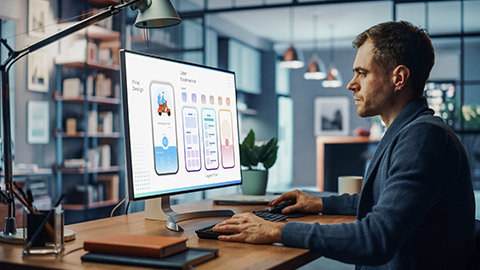Welcome to topic 4 – Create graphic objects. The purpose of this topic is to allow you to experiment and make decisions on your graphic design outcomes, using a combination of design and technical skills.
You will be introduced to the following topics:
- Manipulate, edit, and refine your graphic design outcomes
- Identify and resolve technical requirements.
Experimentation is a crucial part of the graphic design process. It allows you to explore different ideas, techniques, and styles, and ultimately make informed decisions about your design outcomes. Remember, there’s no right or wrong in design. It’s all about what works best for the specific project and audience. So, don’t be afraid to take risks and try something new.
Manipulating, editing, and refining graphic design outcomes involve a series of steps and the use of various tools and techniques. Here are some general steps you might follow:
Understanding the Objective
Before starting any design work, it’s crucial to understand what you’re trying to achieve. This could be conveying a particular message, evoking a certain emotion, or prompting a specific action. Creating a Draft: Start by creating a rough draft of your design. This could be a sketch on paper or a digital mockup. This gives you a starting point to refine from.
Using Design Software
Tools like Adobe Photoshop, Illustrator, and InDesign, or free alternatives like GIMP and Inkscape, are commonly used for manipulating and editing graphic designs. These tools allow you to move elements around, change colours, add effects, and much more.
Manipulating Elements
This could involve changing the size, colour, or position of design elements. You might also manipulate text with different fonts, sizes, and alignments.
Adding Effects
Many design tools allow you to add effects like shadows, gradients, or textures to your design elements.
Refining the Design
This involves making small adjustments to improve the overall design. This could be changing the spacing between elements (known as ‘kerning’ in typography), aligning elements more precisely, or adjusting colors for better contrast.
Getting Feedback
It’s often helpful to get feedback on your design from others. They might spot issues you’ve missed or offer suggestions for improvement.
Finalising the Design
Once you’re happy with your design, you can finalize it. This might involve exporting it in the format needed for its intended use, such as a .jpeg or .png for a website, or a print-ready .pdf for a poster.
Remember, graphic design is a creative process and these steps might not always be linear. You might find yourself going back and forth between steps until you’re happy with the outcome. It’s all part of the design process!
Learn from your design changes
You can use your design changes as an opportunity to learn and grow as a graphic designer. You can reflect on what worked and what didn't work in your design process, and identify the areas where you can improve your skills, knowledge, or workflow.
You can also document your design changes and the reasons behind them, and use them as case studies or portfolio pieces to showcase your problem-solving and creative abilities. You can also ask for testimonials or referrals from your satisfied clients or stakeholders, and use them to build your reputation and credibility as a graphic designer.

Finalising the technical aspects of graphics work involves ensuring that the graphics are properly formatted, optimised, and ready for their intended use. Here are some steps you can take to finalise the technical aspects of your graphics work.
- Check the resolution: Make sure that the resolution of the graphics is appropriate for their intended use. For example, if the graphics is used in print, they should have a resolution of at least 300 DPI, while graphics for web use can have a lower resolution of 72 DPI.
- Optimise file size: If the graphics are used on a website or other digital platform, ensure the file size is optimised for web use. This can be done by compressing images and reducing the file size without compromising quality.
- Check colour mode: Make sure the colour mode is set appropriately for the intended use. For example, graphics for print use should be set to CMYK colour mode, while graphics for web use should be set to RGB colour mode.
- Verify file format: Ensure the file format is appropriate for the intended use. For example, vector graphics should be saved in vector file formats such as SVG or AI, while raster graphics should be saved in image file formats such as PNG, JPEG, or TIFF.
- Proofread: Check the spelling, grammar, and accuracy of any text in the graphics to ensure no errors.
- Get feedback: Share the final graphics with others and get feedback on any areas that could be improved or revised.
By taking these steps, you can ensure that your graphics work is properly formatted, optimised, and ready for its intended use. This can help ensure the graphics effectively communicate the desired message and achieve the desired impact.
Familiarity with popular graphic design software, such as Adobe Photoshop, Illustrator, or InDesign, is often necessary for creating and manipulating graphics. Tools like layers, masks, filters, and blending modes can be important for creating complex and visually appealing designs. The ability to create and manipulate vector graphics, raster images, and other graphic formats, as well as knowledge of file formats, resolution, and compression, is important for ensuring that graphics look good and are optimised for different applications and platforms.
Using an extended range of tools and features of graphic design software with a high level of technical proficiency involves becoming familiar with the full range of features and functionality the software offers and developing expertise in its use.
Here are some tips for developing a high level of technical proficiency with graphic design software.
Many graphic design software companies offer online training courses that cover all aspects of their software. Take advantage of these courses to learn in-depth about the software and its features.
User manuals provide detailed instructions and tips for using the software's features. Take the time to read these thoroughly to learn about the software's full range of functionality.
Numerous video tutorials are available online to teach you how to use specific features or achieve certain effects with the software. Watch these tutorials to learn new techniques and develop your skills.
Practice is essential for developing technical proficiency. Experiment with the software's features and functionality to become familiar with their use and to develop your skills.
Online communities, such as forums or social media groups, provide a platform for discussing software features, asking questions, and sharing tips and tricks. Join these communities to learn from others and stay current on the latest techniques and features.
Developing a high technical proficiency with graphic design software allows you to work more efficiently and effectively and create designs that meet the highest professional standards.
